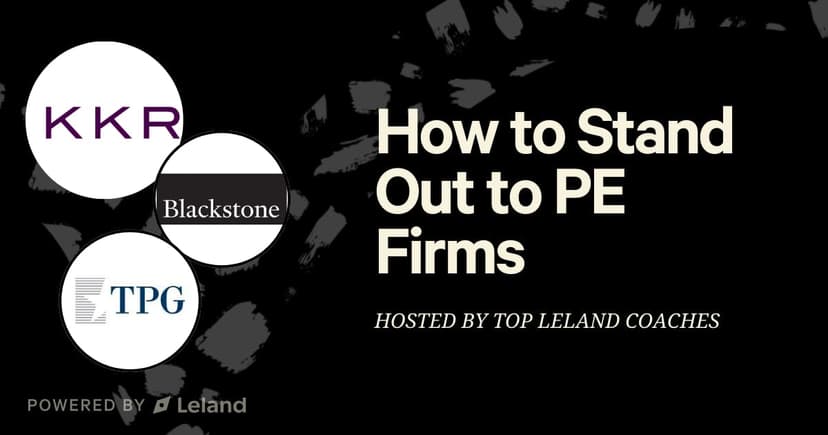Private Equity Secondaries: Interview Guide & Questions
Explore key private equity secondaries interview questions with expert-backed guidance, clear frameworks, and examples to sharpen your pitch.
Posted August 8, 2025

Join a free event
Learn from top coaches and industry experts in live, interactive sessions you can join for free.
Table of Contents
If you’re prepping for a private equity secondaries interview, you already know the basics: LBOs, NAV, DPI. But what separates a good candidate from a great one isn’t modeling. It’s thinking like a secondaries investor. That means understanding fund pacing, alignment risk, and what makes a deal worth pursuing now.
This guide will walk you through the entire process, from technical prep to case studies, and help you stand out for the right reasons.
Read: How to Get Into Private Equity: The Ultimate Guide
What Are Private Equity Secondaries And What Makes Them Different?
Private equity secondaries involve the buying and selling of pre-existing investor commitments to private equity funds. Unlike primary private equity, where investors commit capital at a fund’s inception, secondaries allow buyers to acquire interests partway through the fund’s lifecycle, often with better visibility into its performance and portfolio.
There are two main types of secondaries:
- LP-led transactions: A limited partner sells some or all of its stake in one or more private equity funds.
- GP-led transactions: A general partner restructures or extends the life of a fund, often using a continuation vehicle to provide liquidity to existing LPs.
What sets secondaries apart from traditional private equity investing is the strategy: there’s no control of the underlying portfolio companies, and the focus is on timing, pricing, and cash flow predictability rather than operational improvements.
Secondaries firms look for candidates who can understand the nuances of the secondary market, including how to evaluate assets indirectly through fund-level data, assess GP quality, and underwrite NAV-based returns with discipline.
Mini Case Example: A pension fund wants to exit a tail-end buyout fund that has 5 companies remaining. A secondaries firm underwrites the deal at an 18% discount to NAV, based on its own cash flow projections and fund pacing strategy. The firm acquires the LP interest, betting on faster-than-expected liquidity.
Read: Private Equity Interviews: The Ultimate Guide
Interview Process: What to Expect
The interview process for private equity secondaries roles is rigorous and multi-staged, designed to test both technical depth and investment judgment.
Here’s a typical interview structure:
- Stage 1: Phone screen – resume walkthrough, motivation, basic fit
- Stage 2: Technical round – accounting, LBO concepts, NAV math
- Stage 3: Case study – often a 48-hour take-home modeling exercise
- Stage 4: Culture & fit – conversations with senior team members
Common formats include:
- Modeling tests (e.g., build a simple secondaries LBO model)
- Deal discussions (e.g., assess a past GP-led transaction)
- Market perspectives (e.g., trends in the secondaries asset class)
What secondaries firms test: Analytical depth, judgment, and market understanding. Not just modeling accuracy, but your ability to assess risk, timing, and manager quality.
Typical PE Secondaries Interview Timeline
| Timeline | Prep Milestone |
|---|---|
| 2+ weeks out | Refresh your accounting knowledge, revisit LBO fundamentals, and start practicing secondaries-specific modeling. Study recent GP-led and LP-led transactions to understand structure, pricing, and market dynamics. Begin reading fund tear sheets, secondaries deal reports, and relevant newsletters. If possible, connect with alumni or industry contacts at secondaries firms to gain insight into firm strategy and expectations. |
| 1 week out | Complete at least one or two full-length case studies, ideally using secondaries-specific examples. Build or review a secondaries LBO model that includes NAV analysis, preferred equity mechanics, and implied IRR scenarios. Research the firm’s portfolio companies, investment banking strategy, recent deals, and key investors. Look at how the firm positions itself within the broader private markets ecosystem. |
| 48 hours before | Finalize your behavioral and market-driven answers by writing out responses and practicing aloud. Prepare three firm-specific questions that show strategic insight into their fund pacing, sourcing edge, or market outlook. Review your notes on GP-led dynamics, fund NAV trends, and deal structuring considerations. Rehearse a mock case study or walk through a recent proposed deal to sharpen your delivery and timing. |
How to Prepare for a Private Equity Secondaries Interview
To stand out in private equity secondaries interviews, preparation needs to be structured, strategy-specific, and reflective of how secondaries investors actually think. It’s not just about technical skills — it’s about developing conviction, fluency in fund-level dynamics, and the ability to evaluate deals with judgment and speed.
Structured Prep Timeline
2+ Weeks Out
Lay the technical foundation. Refresh your accounting and modeling skills, but go beyond traditional LBOs. Learn how secondaries investors price NAVs, underwrite fund cash flows, and evaluate GP/LP alignment. Read recent transactions (especially GP-led restructurings) and get comfortable with continuation vehicle mechanics, preferred equity terms, and liquidity pacing.
1 Week Out
Put theory into practice. Work through at least one full case study involving a real or simulated secondaries deal. Practice building an LBO model with secondary-specific inputs (e.g. NAV discount, DPI forecasts, tail-end funds). Analyze recent deals done by the PE firm you’re interviewing with, such as how they were priced, why now, and what risks they were underwriting.
48 Hours Before
Sharpen your thinking. Finalize responses to behavioral and strategy questions. Write out your views on where the secondaries market is headed, and how the private equity firm positions itself competitively. Prepare 2–3 thoughtful, deal-specific questions to ask your interviewers that reflect deep familiarity with their portfolio or sourcing strategy.
Best Research Sources
- Investor Presentations and Tear Sheets - Useful for understanding fund pacing, portfolio companies, and manager commentary.
- Continuation Vehicle Announcements - Study how deals are structured, priced, and communicated to LPs and the market.
- 10-Ks and Earnings Calls (Ares, Blackstone, Apollo) - Public secondaries players often give valuable insight into fund performance and market outlook.
- Secondaries Investor, PitchBook, and Preqin - For trends, deal volumes, and competitor moves in the private markets ecosystem.
Frameworks to Master
To perform like an insider, you need more than surface-level knowledge. Here are the frameworks that top candidates use to analyze secondaries private equity interviews with clarity and conviction:
NAV-Based Valuation
This is the cornerstone of secondaries analysis. Understand how deals are priced relative to NAV, what drives discounts or premiums, and how the liquidity horizon influences target IRR. You should be able to explain how rising or falling interest rates affect valuation sensitivity especially in tail-end funds or volatile portfolios.
Preferred Equity Mechanics
Secondaries firms often invest through continuation vehicles or structured solutions. You’ll need fluency in waterfalls, distribution sequencing, and preferred return features. Know how cash-on-cash distributions flow, and how upside gets shared between existing LPs, new investors, and the GP.
Portfolio Construction
A strong secondaries investor can evaluate risk and return not just at the deal level, but across an entire portfolio. Be ready to speak to diversification across vintages, fund strategies, asset classes, and industries, and how that affects expected liquidity, downside protection, and pacing over time.
LP vs GP-Led Strategy
Finally, you need to show you understand both sides of the market. Be prepared to articulate how a secondaries firm’s sourcing strategy, risk appetite, and return profile differ when pursuing LP-led purchases versus GP-led restructurings. The ability to contrast motivations, information asymmetries, and deal structures will set you apart.
Expert-Recommended Reading List
- ILPA Principles – Required reading to understand what Limited Partners care about
- PitchBook / Preqin Secondaries Reports – Especially trends in GP-led volume, pricing spreads, and dry powder
- Academic Papers on NAV Discounting – For bonus points, reference research-backed approaches to valuation
Key Private Equity Secondaries Interview Questions
Rather than memorize model answers, strong candidates approach each question with a structured, secondaries-specific lens. This table shows how to think through common questions and why they matter in interviews.
| Interview Question | How to Approach It | What It Reveals to the Interviewer |
|---|---|---|
| Walk me through a secondaries LBO model | Anchor your model on NAV entry price, expected cash flow distributions, and interest expense assumptions. Include base, downside, and upside IRRs. | Tests whether you can underwrite fund-level risk without direct control of companies — and build a clean, defensible model. |
| How would you value a portfolio of LP interests? | Break it down by NAV, unfunded commitments, vintage year, GP track record, and expected liquidity over time. Apply a discount based on DPI trends. | Gauges whether you understand secondaries valuation mechanics and can price risk using imperfect information. |
| How do you think about tail-end funds? | Discuss risks around stale assets, longer hold periods, and limited visibility into GP strategy. Weigh optionality vs. cost of capital. | Reveals how you assess low-liquidity investments and whether you think like a long-term investor with disciplined judgment. |
Pro Tip: Practice building a secondaries-specific LBO using assumptions from a real continuation vehicle deal. Focus on pacing, residual NAV, and exit timing.
Modeling in Secondaries vs. Traditional Private Equity
Understanding how modeling differs in secondaries is a key edge in interviews. This comparison frames how secondaries require a different mindset — one that’s more probabilistic, cash flow–driven, and time-sensitive.
| Category | Traditional PE | Secondaries PE |
|---|---|---|
| Entry Pricing | Based on company EBITDA multiples and projected growth | Based on fund NAV, adjusted for discount, unrealized upside, and vintage skew |
| Visibility | Low post-close visibility into future performance | High transparency from historical fund cash flows and company exits |
| Control | Full or majority ownership and operational influence | No control — minority LP stakes in blind pools or known portfolio companies |
| Time Horizon | 5–7 years on average | 2–4 years — shorter duration due to vintage aging and liquidity windows |
| Valuation Risk | Dependent on business execution and market timing | Driven by NAV accuracy, DPI pacing, and GP quality |
| Sources of Return | Primarily operational upside and multiple expansion | Discount capture, early cash, and timing-driven IRR from faster fund turnarounds |
Market & Strategy Questions
These questions are designed to test how you analyze the secondaries market, assess a firm’s strategy, and think like an investor in an evolving private markets landscape. Your responses should show structured thinking, commercial awareness, and a nuanced understanding of where secondaries sit within the broader alternatives ecosystem.
| Sample Question | How to Approach It |
|---|---|
| What’s driving growth in GP-led secondaries? | Explain how the need to provide liquidity to LPs, growing fund sizes, and longer hold periods have made continuation vehicles a common tool. Connect this to GP incentives and the ability to extend AUM and carry exposure. |
| Who are the main players and how do they compete? | Compare firms like Ardian, Lexington, and Goldman Vintage by fund size, geographic focus, sourcing edge, and track record in complex deal structures. Explain how sourcing and structuring advantage drives alpha. |
| What trends will impact returns in 3–5 years? | Discuss factors like rising interest rates, tighter debt financing terms, slower fund pacing, and valuation pressure on legacy portfolios. Show you understand how macro shifts affect NAV discounts and IRR sensitivity. |
SWOT Framework for Analyzing a Secondaries Firm:
Use this framework when evaluating a secondaries platform during your prep or when asked about the firm’s market positioning in interviews:
- Strengths - Deep LP relationships, speed to execute, and underwriting discipline from historical deal flow across vintages and asset classes.
- Weaknesses - Over-reliance on GP-leds or limited ability to source LP-led deals outside of banked processes.
- Opportunities - Expansion into strategic buyer partnerships, credit secondaries, or global diversification. Capitalizing on LP liquidity needs in volatile markets.
- Threats - Mispricing driven by aggressive NAV assumptions, declining exit activity, or rising interest rates compressing forward IRRs.
Behavioral & Role-Specific Questions
Secondaries investors don’t just want model jockeys; they’re looking for people who demonstrate sound judgment, mature communication, and a real investor’s mindset. Your answers should reflect clarity of thinking, an understanding of secondaries trade-offs, and self-awareness about how you make decisions.
| Sample Question | What They’re Evaluating |
|---|---|
| Tell me about a non-consensus decision | Whether you can form an independent view using incomplete data and defend it using logical, data-driven confidence. |
| Why secondaries vs. direct PE or credit? | How well you understand secondaries as an investment banking strategy: its risk-return profile, skillset alignment, and pacing. |
| What’s your investment philosophy? | Whether you prioritize downside protection, timing, and manager quality, and can articulate tradeoffs with nuance. |
Expert Insight:
“We don’t need people who can just build models. We want people who can think like LPs, challenge assumptions, and read between the lines of a GP memo. The best hires aren’t just sharp — they’re skeptical in the right places.” — Managing Director, Global Secondaries Platform
How to Tackle Private Equity Secondaries Case Study Tests
1. Clarify the Deal Structure First
Before modeling anything, make sure you understand what kind of deal you're analyzing. Is it a GP-led continuation vehicle, an LP-led strip sale, or a tender offer? Who controls the process? Is the private equity firm rolling its carry? These details shape everything from what data you’ll receive to what return profile is achievable.
2. Assess the Fund Behind the Deal
Dig into the fund’s NAV, unfunded commitment, vintage year, and GP track record. How recent are the valuations? Has there been meaningful DPI? Which portfolio companies remain, and how exposed is the fund to specific industries, geographies, or macro risks? Great candidates don’t just model the NAV, they interrogate it.
3. Model Cash Flows Around Realistic Scenarios
Build base, upside, and downside cases for future cash flows. Your assumptions should reflect exit timing, GP quality, and pacing. What IRR do you hit in each case? Where is most of your return coming from: NAV discount, yield, or residual upside? Use implied IRR to value the trade and calibrate your bid.
4. Stress-Test the Assumptions
Once your base model is built, stress test it. What happens if interest rates stay high, exit markets slow down, or DPI lags another year? Shift exit timelines or tweak the debt load in continuation vehicles. Secondaries investing is as much about underwriting what could go wrong as it is projecting upside.
5. Frame Your Recommendation Like an Investor
Don’t just say “I’d buy this.” Articulate when and why, and at what price. What makes this deal attractive relative to opportunity cost? What risks do you care about most, and how are you mitigating them? Can you defend your assumptions in front of a skeptical investment committee?
Sample Private Equity Secondaries Case Studies
| Case Study | What Works | What Doesn’t |
|---|---|---|
| LP stake sale in a 2014 vintage buyout fund | Recognizing that the fund has distributed most of its capital, the remaining cash flows are highly visible. Points out that NAV is conservative, companies are de-risked, and potential DPI is achievable within 12–18 months. Frames the bid in terms of liquidity timing, discount to NAV, and vintage diversification. | Treating it as a generic LP-led without digging into recent capital structure shifts or GP-level incentives. Ignores whether the fund is truly tail-end or artificially being held open. Doesn’t question whether the seller might know something the buyer doesn’t. |
| GP-led continuation vehicle with 7 portfolio companies | Analyzing each underlying company’s earnings, exit timeline, and sponsor thesis. Flags deal structure risks (e.g., preferred equity, waterfall splits) and co-invest dilution. Models different timing assumptions and considers what return the GP is underwriting. Evaluates whether the GP is rolling meaningful carry and how aligned they are with new investors. | Fixating on IRR in isolation. Models outputs but fails to challenge assumptions. Overlooks key structuring risks, like upside sharing or management team turnover. Doesn’t ask why the GP didn’t sell outright or what pressure points led to this deal. |
Good vs Great Secondaries Interview Responses
In private equity secondaries interviews, the bar is high. Most candidates can build a clean model, explain NAV discounts, and talk through a basic case. But the top 5% distinguish themselves by how they think, not just what they know.
Top candidates show up like investors, not technicians. They challenge assumptions, weigh risk and timing tradeoffs, and bring a dual mindset: What would a GP think here? What would an LP be concerned about? They understand that secondaries isn’t just about cash flow modeling, it’s about structuring, alignment, and judgment.
If you want to stand out, your goal isn’t to get the “right” answer — it’s to demonstrate investor-level thinking that shows you can operate in ambiguity and still underwrite a smart decision.
Here are a few things that consistently differentiate the strongest candidates:
- They discuss fund pacing, residual tail risk, or liquidity windows, not just IRR
- They ask questions about GP incentives, co-invest dilution, or continuation vehicle terms
- They don’t just say “I’d invest”. They say “I’d invest at a 12% IRR if liquidity comes in 24 months, assuming NAV integrity holds”
- They understand that secondaries returns are driven by timing, not just growth
Good vs Great Secondaries Interview Responses
| Prompt | Good Answer | Great Answer |
|---|---|---|
| Would you invest in this deal? | “Yes, it looks like a solid portfolio and the IRR is above our hurdle.” | “At the right price, yes — but only if distributions start within 18 months. The GP is strong, but I’d push on their exit timeline and ask why they’re not selling outright.” |
| What risks concern you here? | “Maybe market risk or valuation risk.” | “NAV compression due to delayed exits, possible misalignment from recycled carry, and a top-heavy cap table in one of the portfolio companies. I’d also stress test DPI at exit.” |
| What makes this GP-led attractive? | “The GP has a strong track record.” | “The GP is rolling 100% of their carry, which is a great alignment signal. Also, three of the seven companies are pre-exit and two just refinanced — so we likely get front-loaded cash flow.” |
| What would you ask the GP? | “I’d ask about their exit plans.” | “I’d ask which companies they considered selling externally and why they chose continuation instead. Also, how are co-investors being treated in this structure, and what does that imply for upside sharing?” |
Need More Help Navigating PE Secondaries Interviews?
Cracking a secondaries interview takes more than prep. It takes perspective. Connect with an expert private equity coach who’s been on the other side of the table. Browse PE Coaches here. You can also check out private equity bootcamps and free events to unlock your full PE potential.
See: The 10 Best Private Equity Career Coaches for Interview Prep & Training
Read these next:
- 50+ Case Interview Questions and Examples From Top Firms
- The 10 Best Questions to Ask Your Interviewer in a Private Equity Interview
- 20+ Second-Round Interview Questions You Need to Know
- Finance Internships for College & High School Students
- The Best Venture Capital & Private Equity Newsletters and Podcasts
- Top Skills You Need to Break Into Private Equity
FAQs
What’s the best way to prepare for a private equity secondaries interview?
- Build fluency in NAV-based valuation, recent secondaries transactions, and fund pacing mechanics. Practice modeling and structuring a GP- or LP-led deal.
Why do firms ask about LP-led vs GP-led transactions secondaries in interviews?
- Because it reveals how well you understand deal structure, liquidity timing, and incentive alignment.
What technical skills are most important for secondaries interviews?
- Cash flow modeling, discount to NAV math, scenario analysis, and understanding of capital structure and balance sheet mechanics.
How does a secondaries interview differ from a traditional PE interview?
- Less focus on operating levers or management teams, more on fund dynamics, return timing, and strategic LP perspectives.
Can you give an example of a secondaries case study question?
- “Here’s a GP-led continuation vehicle deal memo. Walk us through whether you’d invest, at what price, and what questions you’d ask the GP.”
Browse hundreds of expert coaches
Leland coaches have helped thousands of people achieve their goals. A dedicated mentor can make all the difference.
















